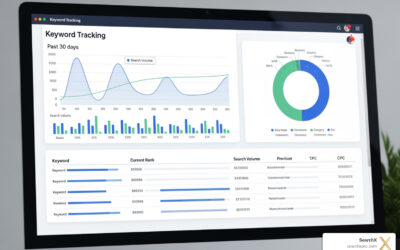Creating an SEO content calendar ensures you’re publishing the right content at the right time to improve search rankings and engage your audience. Without one, content creation can feel disorganized, leading to missed opportunities and inconsistent results.
Here’s a quick breakdown of what an SEO content calendar does:
- Organizes content: Includes keywords, formats, deadlines, and team assignments.
- Targets audience needs: Aligns content with search intent and seasonal trends.
- Improves SEO: Boosts rankings by consistently publishing optimized content.
- Tracks performance: Measures success using tools like Google Analytics and Search Console.
To create one:
- Research your audience and keywords.
- Match keywords to content types (e.g., blogs, videos).
- Use tools like Google Sheets, Trello, or Notion for planning.
- Set realistic publishing schedules and track progress.
Setting Goals and Building Your Foundation
Research Your Target Audience
Start by diving into your customer data and analyzing behavioral patterns to pinpoint your target audience. Once you understand who they are, you can choose keywords and content formats that resonate with their preferences and address their needs. This understanding becomes the cornerstone for focused keyword research and effective topic planning.
Watch Me Build a 6-Month SEO Content Calendar (Step by Step)
Keyword Research and Topic Planning
Turn your audience insights into a powerful content strategy by identifying the right keywords and using them to plan content that attracts organic traffic. This step bridges your audience research with actionable ideas to grow your online presence.
Research Keywords for Your Content
Start with seed keywords that represent the core of your business. For instance, a fitness coaching business might begin with terms like "weight loss", "strength training", or "nutrition coaching." From these starting points, you can expand into more specific, long-tail keywords that reflect actual search behaviors.
Use tools like Google autocomplete to uncover real search queries. For example, typing "weight loss" might reveal phrases like "weight loss for women over 40."
Another free tool to consider is Google Keyword Planner, which provides search volume data and keyword variations. While non-advertisers may only see ranges instead of exact figures, it still offers a solid starting point for gauging keyword popularity. The goal is to find keywords with good search volume that aren’t overly competitive for your business size.
You can also analyze competitors. Check out their blog posts, service pages, and FAQs to spot keywords they’re targeting but you might have missed.
Most importantly, focus on search intent when choosing keywords. Use informational keywords (like "how to lose weight") for blogs and commercial ones (like "best protein powder for weight loss") for service pages. Matching content to search intent ensures your content delivers what users are actually seeking.
Once you’ve identified impactful keywords, align them with the right content format.
Match Keywords to Content Types
Different types of keywords are better suited to specific content formats. Informational keywords such as "how to", "what is", or "best ways to" work well for blog posts and guides. For commercial investigation keywords like "best protein powder for weight loss", comparison articles or detailed service pages are a better fit. Meanwhile, transactional keywords containing terms like "buy", "hire", or location-specific phrases should guide your service pages and local SEO content.
Don’t underestimate the value of long-tail keywords, as they’re often more specific and face less competition. For example, "beginner strength training routine for women" is far more targeted than "strength training", making it more likely to convert.
Also, keep an eye on seasonal trends when planning your content. Searches like "New Year workout plans" spike in January, while "summer body workout" gains traction in spring. Sync your content calendar with these trends to maximize visibility.
By prioritizing long-tail keywords and seasonal topics, you can create a content calendar that meets your audience’s needs at the right time.
Organize Topics with the Pillar-Cluster Method
Once you’ve identified your keywords, organize them into a clear structure using the pillar-cluster model. This approach helps both search engines and users navigate your content with ease. A pillar page serves as a comprehensive hub for a broad topic, while cluster content dives into specific subtopics, all interlinked to create a cohesive structure.
For example, a fitness coach could create pillar pages like "Weight Loss Guide", "Strength Training Basics", and "Nutrition Fundamentals." These pages should provide broad coverage of each topic while linking to more detailed cluster content.
Cluster content might include subtopics like "Weight Loss for Busy Professionals", "Healthy Meal Plans for Weight Loss", or "Overcoming Weight Loss Plateaus." Each of these cluster pages should link back to the main pillar page and to other related cluster content.
Strategic internal linking is key here. Your pillar page should target broad, high-volume keywords (e.g., "weight loss guide"), while cluster pages focus on more specific long-tail variations. This signals to search engines that your site is an authority on the topic.
To keep your strategy effective, track performance across your pillar-cluster groups. If a pillar page like "Strength Training Basics" performs well but lacks content on topics like "strength training for seniors" or "home strength training equipment", add those to your content calendar. This ensures you’re covering all relevant subtopics while boosting your SEO.
For businesses aiming to simplify the keyword research and content planning process, professional SEO services can provide tailored strategies, helping you identify impactful keywords and build effective pillar-cluster structures that drive results.
Creating Your SEO Content Calendar
Once your keywords and topics are sorted, it’s time to build the calendar that will guide your content efforts. Every part of your calendar should tie back to your SEO goals and audience engagement. Think of it as your roadmap – each piece of content should have a clear purpose and contribute to your broader strategy.
Key Parts of an SEO Content Calendar
A solid SEO content calendar includes a mix of essential elements: content titles, targeted keywords, content types, publication dates, SEO checklists, promotion plans, and deadlines. Here’s how each piece fits together:
- Content Titles: These should be clear, engaging, and naturally include your target keywords. Avoid generic titles and aim for specific, keyword-rich ones that resonate with your audience.
- Target Keywords: These are the foundation of your content. Assign a primary keyword and 2-3 secondary keywords to each piece. For instance, if your primary keyword is "home workout routines", secondary keywords could be "bodyweight exercises" and "no equipment workouts."
- Content Type: Specify the format for each piece – whether it’s a 1,500-word blog post, a comparison page, an infographic, or a video script. Clear expectations here ensure your team stays on track.
- Publication Dates: Spread your content out evenly to maintain consistent engagement. For example, if you’re posting twice a week, choose specific days like Tuesdays and Thursdays to build a predictable rhythm.
- SEO Optimization Checklists: Include tasks like adding metadata, internal links, image alt text, and schema markup. Having these details upfront saves time during editing.
- Promotion Strategies: Dedicate a column in your calendar to outline how you’ll promote each piece – whether through social media, newsletters, or other channels tailored to the content.
- Deadlines: Set dates for drafts and final edits, working backward from your publication date. This keeps the process smooth and avoids last-minute stress.
Once you’ve outlined these elements, it’s time to choose the tools that will help you manage it all.
Tools and Templates to Use
Google Sheets is a go-to option for many teams. It’s free, easy to use, and collaborative. You can create columns for all your calendar components, color-code content types, and share access with your team.
Other tools to consider include Trello, Airtable, and Notion. Trello is great for visual project management, Airtable combines spreadsheet functionality with database features, and Notion offers a flexible workspace where you can embed research, style guides, and performance tracking.
For businesses ready to invest in dedicated tools, platforms like CoSchedule or ContentCal provide advanced features, including social media integration and analytics. These tools are especially useful for larger teams managing high volumes of content.
If you’re working with an SEO agency, many provide custom content calendar templates as part of their services, often integrated with keyword research and tracking tools.
Set a Realistic Publishing Schedule
Now that your calendar is set up, decide on a publishing frequency that aligns with your resources and audience needs. It’s better to start small and build up than to overcommit. A steady schedule of one well-crafted post per week is far more effective than sporadic bursts of content.
Take into account your industry’s content consumption habits. For example, B2B audiences are often more active during weekdays, while consumer-focused businesses might see better results on weekends. Test different days and times to find what works best.
Also, consider the complexity of your content. Research-heavy guides will take more time than quick tips or opinion pieces. Balance your calendar with a mix of content types to ensure consistent publishing without overwhelming your team.
Build in buffer time for unexpected delays or opportunities to address trending topics. Many successful teams work a few weeks ahead of their schedule, leaving room for flexibility.
Finally, align your schedule with your business goals and seasonal trends. For example, a tax preparation service might ramp up content before tax season, while e-commerce businesses could increase output around Black Friday or back-to-school shopping.
Above all, consistency is key. Both your audience and search engines value regular, predictable updates over erratic publishing. Choose a schedule you can sustain and adjust as your team becomes more efficient.
Tools, Templates, and Best Practices
The tools and templates you choose can transform your SEO content calendar into a powerful driver of growth. By combining the right resources with a clear strategy, your calendar can adapt to your business needs while delivering the consistency that both search engines and audiences expect.
Best Tools for SEO Content Planning
Google Analytics is a must-have for tracking how your content performs. Dive into custom segments and Acquisition reports to pinpoint which posts are delivering results and which might need a refresh.
With Google Search Console, you get direct insights into your content’s search performance. Use the Performance report to spot trending keywords and identify content losing traction, while the Coverage report flags technical issues that could hurt your rankings.
For more advanced keyword research and competitor insights, SEMrush and Ahrefs are excellent choices. SEMrush’s Content Gap tool highlights keywords your competitors rank for that you don’t, while Ahrefs’ Content Explorer helps you discover the most shared content in your niche.
Screaming Frog is invaluable for technical SEO audits. It can identify missing meta descriptions, broken links, and other technical problems. Running monthly crawls ensures your calendar stays on track and technically sound.
Project management tools like Monday.com or Asana are great for keeping your team organized. Assign tasks, set deadlines, and track progress across multiple content pieces effortlessly.
If you’re working with an SEO agency, many offer access to enterprise-level tools and dashboards. For instance, SearchX provides advanced SEO solutions that include tracking and optimization tools tailored to your needs.
Free Templates You Can Use
If you’re just starting out, Google Sheets templates are simple and effective. Include columns for titles, keywords, publication dates, statuses, and performance metrics. Use conditional formatting to visually track overdue tasks and completed items.
Microsoft Excel offers similar functionality but adds powerful features like pivot tables for analyzing trends by month, content type, or keyword difficulty.
For a more visual approach, Trello board templates work wonders. Organize content into lists such as "Ideas", "In Progress", "Ready to Publish", and "Published." Each card can include checklists for tasks like SEO optimization, keyword research, and promotion.
Notion templates are a flexible option for embedding research, style guides, and performance data in one place. Build a master database that connects your content calendar to keyword research, competitor analysis, and tracking metrics.
Many templates also come with pre-built formulas to calculate ROI, track keyword rankings, and measure traffic growth. Tailor these to fit your specific KPIs and reporting needs.
Track Performance and Make Improvements
Once your tools and templates are in place, consistent performance tracking ensures your content stays effective. Evaluate performance at different intervals: weekly for traffic trends, monthly for ranking changes, and quarterly for audits. Focus on metrics that align with your goals, like organic traffic, keyword rankings, and conversions.
If your click-through rates (CTR) in Google Search Console are low, tweak title tags and meta descriptions. Content with high impressions but low clicks often needs better optimization to stand out in search results.
Internal linking is another key area to monitor. Conduct monthly audits to find opportunities to link related content. This not only improves user navigation but also helps search engines understand the relationships between your pages, boosting keyword rankings. SearchX’s technical SEO services include internal linking audits to enhance site performance.
Keeping content fresh is essential, especially for time-sensitive topics. Set up quarterly reviews to update outdated stats, add new insights, or remove irrelevant sections. Google rewards content that remains current and useful.
Track keyword rankings weekly using tools like SEMrush or Ahrefs. If rankings drop, investigate potential causes like competitor activity or shifting search intent. Sometimes, a quick content update or additional internal links can restore lost visibility.
Conversion tracking connects your content to business outcomes. Use Google Analytics to set up goals that track how organic traffic leads to sales or inquiries. This data helps you prioritize high-performing content for further investment.
Test different elements of your content through A/B testing. Experiment with headlines, meta descriptions, or internal links to see what resonates best. Even small improvements in CTR or engagement can lead to significant traffic gains over time.
Lastly, stay ahead with regular competitor analysis. Monthly reviews of competitor content can reveal new keyword opportunities and emerging trends. Tools like Ahrefs’ Content Gap feature simplify this process, making it easier to identify areas where you can gain an edge.
Putting Your SEO Content Calendar to Work
A content calendar only delivers results if it’s executed consistently and adjusted as your goals or circumstances change.
Key Points to Remember
Consistency beats sporadic efforts. Publishing quality content on a regular schedule signals dependability to both your audience and search engines, which helps build trust and authority.
Let keyword research guide your content. Before diving into writing, ensure your target keyword has enough search volume and aligns with your business objectives. Tools like Google Keyword Planner can help confirm demand. Also, take a look at the competition on page one. If the top results are dominated by high-authority sites, consider focusing on a less competitive, long-tail keyword variation instead.
Your calendar should include a variety of content types across the year. Combine educational how-to guides, product comparisons, industry updates, and seasonal topics to keep your audience interested while addressing different stages of their buying journey.
Track performance carefully. Use tools like Google Analytics to measure how your organic traffic converts into leads or sales. When a piece outperforms expectations, analyze its success and replicate those strategies in future content. On the flip side, if something underperforms, dig into the data to understand what went wrong and adjust your approach.
Internal linking is key. As you publish new content, link it to older, related pieces to improve engagement and boost your search rankings.
When your in-house team hits its limit, bringing in outside expertise can take your strategy to the next level.
Getting Professional Help to Scale Up
As your business grows, managing a content calendar may evolve from a simple spreadsheet to a complex, multi-channel operation requiring specialized resources.
SEO agencies bring tools and expertise that in-house teams often lack. They have access to advanced keyword research platforms, competitor analysis tools, and performance dashboards – tools that can cost thousands of dollars a month if purchased individually.
For example, SearchX provides comprehensive SEO solutions that include content calendar management, keyword research, and ongoing optimization. Their Growth plan, priced at $6,000 per month, delivers 6-8 content pieces monthly, alongside technical SEO audits and competitor analysis – services that can be difficult for many businesses to handle internally.
The real value of hiring professionals goes beyond just producing content. Experienced SEO specialists offer strategic insights that can be game-changing. They can identify trends in your data that might take months for an in-house team to notice. They also understand how algorithm updates impact different industries and can adjust your strategy accordingly.
Scaling your content production while maintaining quality requires systems that many businesses don’t have in place. Professional agencies use detailed briefs, editorial calendars, and rigorous quality control processes to ensure every piece aligns with SEO best practices and meets your audience’s needs.
Consider seeking professional help if your organic traffic growth has stalled, if you’re struggling to maintain a consistent publishing schedule, or if you’re looking to expand into new markets or product lines. SearchX’s keyword research services can uncover opportunities you might overlook, while their technical SEO audits ensure your site’s performance doesn’t hinder your content efforts.
Investing in professional SEO support often pays off through higher rankings and increased organic traffic. Many businesses find that partnering with an experienced agency accelerates results far beyond what they could achieve on their own.
FAQs
How can I use seasonal trends to enhance my SEO content calendar?
To make the most of seasonal trends in your SEO content calendar, start by pinpointing major holidays, events, or seasonal themes that resonate with your audience. Create content that ties into these moments, using targeted keywords and appealing visuals that capture the essence of the season.
Get a head start by scheduling blog posts, social media updates, and promotions well in advance of the season’s peak. This way, you can tap into early interest and build momentum. Keep an eye on performance metrics to adjust your approach as needed, ensuring your content remains timely and engaging. With careful preparation, seasonal trends can be a powerful way to enhance your visibility and connect with your audience.
How can I consistently publish high-quality content without missing deadlines?
To keep producing top-notch content regularly, start with a well-structured content calendar. This should include your planned topics, deadlines, and publishing dates. A clear schedule keeps things organized and ensures you’re consistently putting out fresh material. Aim for achievable goals – like publishing one in-depth article per week – to strike a balance between quality and consistency.
It’s also crucial to understand what your audience is looking for. Create content that addresses their needs and provides meaningful value. Don’t forget to revisit older pieces – updating them ensures they stay relevant and engaging. With a solid plan and a focus on quality, you can establish a reliable process for publishing content that truly resonates.
What are the best tools and templates for creating an SEO content calendar that fits my business needs?
Choosing tools and templates for your SEO content calendar should align with your business size, workflow, and objectives. If you’re managing a larger team or dealing with complex projects, tools like CoSchedule or ClickUp can be game-changers. They offer advanced features for collaboration and scheduling, making it easier to keep everyone on the same page.
For smaller businesses or those who prefer simplicity, platforms like Google Sheets, Notion, or Airtable provide customizable templates that are both flexible and straightforward.
The key is to pick tools that are user-friendly, integrate seamlessly with your current processes, and support your specific SEO goals. The right setup will simplify planning and execution, keeping your content strategy focused and effective.




